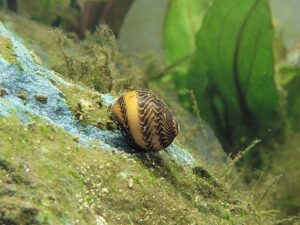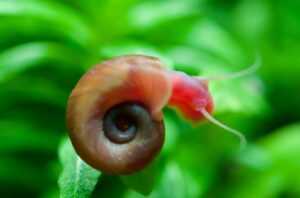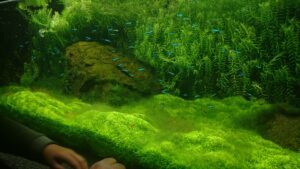
11 Types Of Ram Cichlids You Should Have

Writer at The Aquarium Keeper
Ram cichlids are relatively popular amongst fish keepers because they are one of the easiest cichlid species to take care of, they don’t need a lot of space, and their coloration is absolutely magnificent.
There are a lot of different types of ram cichlids available in this hobby, some have been in the hobby for years, while other variants are slowly being introduced. In this article, I will break down 11 different types of ram cichlids, that you should definitely have if you are interested in these species.
General Guidelines For Keeping Ram Cichlids Successfully
If you are just slowly getting into the cichlid world, you would need to know some general guidelines, for keeping ram cichlids successfully. Here are things, that you should know:
- Ram cichlids are generally peaceful, but can sometimes show aggression while breeding. These species form pairs, so it is best to have equal numbers of male and female ram cichlids in your tank. They do fine with other types of fish, and can peacefully live in community tanks.
- Ram cichlids are relatively sensitive to sudden water parameter changes, and can’t handle large amounts of ammonia or other toxic elements. Be sure to keep your water parameters stable, and do 25% weekly water changes.
- Add lots of plants and hiding places for your ram cichlids. These species love digging around the substrate, so pick column-feeding aquarium plants, that are hardy, and don’t need to be particularly planted.
- Buy only healthy ram cichlids from your pet stores. Don’t pick rams, that are very skinny, have already visible injuries, or have strange behavior. Try choosing ram cichlids, that are actively swimming and eating.
Knowing these basic facts about ram cichlids will definitely help you avoid any unnecessary casualties in your aquarium. Be sure to also follow certain requirements for all the types of ram cichlids, as some variants may have slightly different needs than others.
Types of Ram Cichlids
When it comes to ram cichlids, there are a lot of different types, that vary in body shape and color. The most popular ones are german blue, golden, wild, and bolivian ram. The more uncommon variants are the angel and the black german ram.

To begin this ram cichlid list, I have to mention, that every mentioned ram can look slightly different from the photos, that are used in this article. Rams often have slightly different colorations, and that can be the result of tank conditions, stress levels, diet, and whether or not they are breeding.
Wild German Ram
Firstly, the list begins with the type of ram cichlid, that is found in the wild. It is called the wild german ram, and all the other types of ram cichlids were bred from this variant.

The wild german ram is not as colorful as captive-bred variants. Their body is usually silver in color, with bright blue spots covering the entire body and fins. These blue spots can sometimes look more bright, depending on the lightning the fish is swimming in. The wild german ram also can have yellow coloration and black stripes on the body, while almost always having a black stripe going across the red eye of the fish. Here is more information about these species:
- Scientific name: Mikrogeophagus ramirezi wild
- Origin: South America (Found in the Orinoco River in Venezuela and Colombia)
- Rarity: Uncommon
- Price: Can cost from 5$ to 15$ per fish
- Care level: Easy
- Water Temperature: 28–30 °C (82–86 °F)
- pH: 6.0–7.5
- Minimum Tank Size: 20 gallons for a pair
- Diet: Omnivorous ( in the wild, wild ram cichlids eat small insects, crustaceans, and occasionally plant matter. In an aquarium they can eat fish flakes, pellets, brine shrimp, and bloodworms)
- Temperament: Peaceful, but can be aggressive while breeding
- Lifespan: 2-4 years
- Size: up to 2 inches (5 cm)
The wild german cichlid variant is still available in some aquatic stores and online retailers but is not as popular as it used to be. Nowadays there are more vibrant-looking ram cichlid types, that gain more attention, than the basic wild ram cichlid.
German Ram
Moving on, probably the most popular type of ram cichlid is the german ram. Compared to the wild ram cichlid, it is more colorful and vibrant and is pretty much globally available everywhere.

The german ram got its name when originally this type was bred from wild ram cichlids in Germany. These species have all sorts of colors (blue, yellow, orange, red) covering its body, and they can often resemble a rainbow. Here is more information about the german ram:
- Scientific name: Mikrogeophagus ramirezi
- Origin: Originates from South America, but are mainly captively bred
- Rarity: Common
- Price: Can cost from 10$ to about 15$
- Care level: Easy
- Water Temperature: 28–30 °C (82–86 °F)
- pH: 6.0–7.5
- Minimum Tank Size: 20 gallons for a pair
- Diet: Omnivorous (can eat bloodworms, fish flakes, pellets, and plant matter)
- Temperament: Peaceful but can be aggressive while breeding
- Lifespan: 2-4 years
- Size: up to 2 inches (5 cm)
German rams also have more colorful fins than the wild ram cichlid. Their fins usually are orange or red in color, and they also have bright blue dots all around their fins and body. The german ram is a great addition to any community tank.
German Longfin Bubble Ram
A slightly more rare type of ram cichlid is the german longfin bubble ram. These species are captively bred from the german rams, and their fins are way longer. Longfin bubble rams are even more colorful but require larger aquariums due to their size.

The german longfin bubble ram is specifically bred to have longer fins since for some people it looks more beautiful when a fish has longer fins. They are very rare, and only a couple of breeders on online retailers sell them. They look almost exactly the same as a standard german ram, but their fins are almost twice the size, and occasionally they have brighter colors. Here is more information about these species:
- Scientific name: Mikrogeophagus ramirezi ‘longfin’
- Origin: Captively bred, but originates from South America
- Rarity: Rare
- Price: Can cost from 10$ to about 15$
- Care level: Easy
- Water Temperature: 28–30 °C (82–86 °F)
- pH: 6.0–7.5
- Minimum Tank Size: 30 gallons per pair
- Diet: Omnivorous (can eat bloodworms, brine shrimp, flakes, pellets, and plant matter)
- Temperament: Peaceful, but can be aggressive while breeding
- Lifespan: 2-4 years
- Size: up to 3 inches (7.62 cm)
Since they are larger than the standard german ram, they also need more space to swim. For a pair of german longfin bubble rams, you should at least aim to have a 30-gallon aquarium. This ram variant is also less active since it has these huge fins, that can sometimes slow down the fish.
Golden Ram
Moving on, another relatively popular type of ram cichlid is the golden ram. It is also a captively bred dwarf cichlid species, that originate from the basic wild ram.
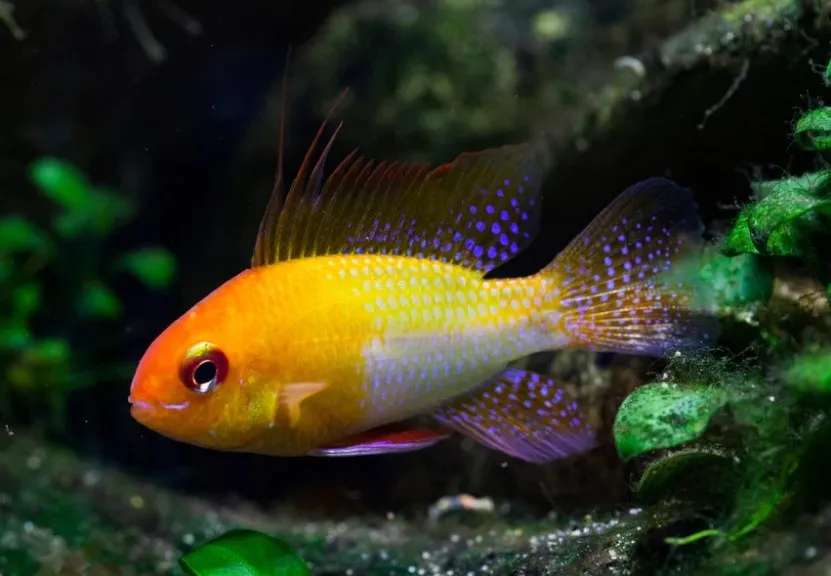
Golden rams are extremely common, similar to german rams. They got this name because of their coloration, which often has colors like yellow, orange, and white. The head of the fish is usually the darkest orange, while the body becomes more and more yellowish. Here is more information about the golden ram cichlid:
- Scientific name: Mikrogeophagus ramirezi ‘Gold’
- Origin: Captively bred, but originates from South America
- Rarity: Common
- Price: Can cost from 8$ to about 15$
- Care level: Easy
- Water Temperature: 28–30 °C (82–86 °F)
- pH: 6.0–7.5
- Minimum Tank Size: 25 gallons for a pair
- Diet: Omnivorous (can eat fish food, pellets, plant matter, bloodworms, brine shrimp, and insect larvae)
- Temperament: Peaceful, but can become aggressive while breeding
- Lifespan: 2-4 years
- Size: up to 2.5 inches (6.35 cm)
Similar to german rams, these species also have bright blue dots all around their body and fins, while the fins themselves are orange or reddish in color. The orange ram cichlid looks absolutely amazing in darker aquarium setups, because of the contrast of the fish color and the dark substrate or decorations.
Golden Balloon Ram
A more interesting type of ram cichlid is the golden balloon ram. It has a very similar appearance to the basic golden ram, but the body of the fish is shorter and more round.

Golden balloon rams are also captively bred, but they don’t have any other significant differences apart from their body shape. These species have slightly shorter fins and can resemble a fancy goldfish in terms of their body shape. Here is more information about the golden balloon ram:
- Scientific name: Mikrogeophagus ramirezi ‘Golden Balloon’
- Origin: Captively bred, but originates from South America
- Rarity: Uncommon
- Price: Can cost from 10$ to about 15$
- Care level: Easy
- Water Temperature: 28–30 °C (82–86 °F)
- pH: 6.0–7.5
- Minimum Tank Size: 20 gallons for a pair
- Diet: omnivorous (can eat bloodworms, plant matter, fish food, pellets, brine shrimp)
- Temperament: Peaceful, but can become aggressive while breeding
- Lifespan: 1-2 years
- Size: up to 2 inches (5 cm)
Golden balloon rams are not as common as the basic golden rams. They are slowly being introduced into this hobby, and only a handful of pet stores at online retailers sell them.
Black German Ram
Moving on, a new addition to the dwarf cichlid family is the black german ram. It is a fairly rare type of ram cichlid, and it is absolutely gorgeous, although they can be pretty pricy, compared to the more available variants.

More fancy dark german rams are completely black, while their fins are orange in color and have blue spots on them. Basic black german rams often are dark grey in body color and can have darker spots on their body and eyes. Here is more information about these species:
- Scientific name: Mikrogeophagus ramirezi ‘Black’
- Origin: Captively bred, but originates from South America
- Rarity: Rare
- Price: Can cost from 20$ to about 50$
- Care level: Easy
- Water Temperature: 28–30 °C (82–86 °F)
- pH: 6.0–7.5
- Minimum Tank Size: 20 gallons for a pair
- Diet: omnivorous (can eat bloodworms, plant matter, fish food, pellets, brine shrimp)
- Temperament: Peaceful, but can become aggressive while breeding
- Lifespan: 2-4 years
- Size: up to 2 inches (5 cm)
Electric Blue Ram
Another one of the most widely available and popular types of ram is the electric blue ram cichlid. Even though they look absolutely stunning, these species are fairly common.

Electric blue ram cichlids are almost completely blue in color. The head is usually darker blue than the body, but sometimes the head part can also have other colors on it, like yellow or orange. This fish can always look different if the lightning in the aquarium change. Here is more information about the electric blue ram cichlid:
- Scientific name: Mikrogeophagus ramirezi ‘Electric Blue’
- Origin: Captively bred, but originates from South America
- Rarity: Common
- Price: Can cost from 10$ to about 20$
- Care level: Easy
- Water Temperature: 28–30 °C (82–86 °F)
- pH: 6.0–7.5
- Minimum Tank Size: 20 gallons for a pair
- Diet: omnivorous (can eat plant matter, fish food, pellets, brine shrimp, bloodworms)
- Temperament: Peaceful, but can become aggressive while breeding
- Lifespan: 2-4 years
- Size: up to 2 inches (5 cm)
Electric blue rams usually look the best in dark fish tanks. Be sure to get a darker substrate and a black background, if you really want that blue color to show in your aquarium.
Electric Longfin Blue Ram
There are a couple of ram cichlids types, that are way more new than others. Electric longfin blue ram is one of them, and there are not many of these species available, so if you find any, consider yourself lucky.

Electric longfin blue rams look exactly the same as the basic electric blue rams, but their fins are twice as long, and their body is also bigger. Make sure that you can afford to have at least a 30-gallon tank if you want to keep this ram cichlid type. Here is more information about these species:
- Scientific name: Mikrogeophagus ramirezi ‘Electric Blue Longfin’
- Origin: Captively bred, but originates from South America
- Rarity: Rare
- Price: Can cost from 15$ to about 25$
- Care level: Easy
- Water Temperature: 28–30 °C (82–86 °F)
- pH: 6.0–7.5
- Minimum Tank Size: 30 gallons per pair
- Diet: Omnivorous (can eat bloodworms, brine shrimp, flakes, pellets, and plant matter)
- Temperament: Peaceful, but can be aggressive while breeding
- Lifespan: 2-4 years
- Size: up to 3 inches (7.62 cm)
Electric longfin blue ram fins are actually slightly transparent but still have the blue coloration. Similar to the basic electric blue ram, it is best to keep this variant in darker setups, so you would get the most out of this fish.
Electric Balloon Ram
Moving on, another balloon-type ram cichlid is the electric balloon ram. These species are also harder to find since it requires a lot of time and effort to actually breed this variant.

Electric balloon rams are also completely covered in blue color, the head is darker and the body is lighter blue. The fins on this type of ram are shorter, while the body is more round, similar to a fancy goldfish. Here is more information about the electric balloon ram:
- Scientific name: Mikrogeophagus ramirezi ‘Electric Balloon’
- Origin: Captively bred, but originates from South America
- Rarity: Rare
- Price: Can cost from 15$ to about 25$
- Care level: Easy
- Water Temperature: 28–30 °C (82–86 °F)
- pH: 6.0–7.5
- Minimum Tank Size: 20 gallons for a pair
- Diet: omnivorous (can eat bloodworms, plant matter, fish food, pellets, brine shrimp)
- Temperament: Peaceful, but can become aggressive while breeding
- Lifespan: 1-2 years
- Size: up to 2 inches (5 cm)
Electric balloon ram can actually have a shorter lifespan since the organs and the body of the fish are more compact, which can cause digestion or organ failure problems in the future.
Bolivian Ram
Another type of ram cichlid, that can actually comes from the wild, and is not captively bred, is the bolivian ram. It is a beautiful ram cichlid, but is fairly common, compared to other types on this list.

The bolivian ram has a unique appearance: nearly half the body from the head is orange or dark yellow, while the other half is gray. The body can also have dark spots on it, while the fins of the fish are transparent, but can have red coloration at the very end. Here is more information about these species:
- Scientific name: Mikrogeophagus altispinosus
- Origin: South America (Amazon River, Brazil and Bolivia)
- Rarity: Common
- Price: Can cost from 10$ to about 15$
- Care level: Easy
- Water Temperature: 22–28 °C (72–82 °F)
- pH: 6.0–7.5
- Minimum Tank Size: 30 gallons for a pair
- Diet: omnivorous (can eat bloodworms, plant matter, fish food, pellets, brine shrimp)
- Temperament: Peaceful, but can become aggressive while breeding
- Lifespan: 4-6 years
- Size: up to 3 inches (7.62 cm)
Compared to other types of ram cichlids, the bolivian ram is quite large and can reach up to 3 inches (7.62 cm) in length. Because of the size, you would need at least 30 gallons to house a pair of these beautiful fish.
Angel Ram
The last type of cichlid on this list is the rare angel ram. There is not a lot of information about this type of ram, only that is fairly new to this hobby, and that the appearance of this fish is truly amazing.
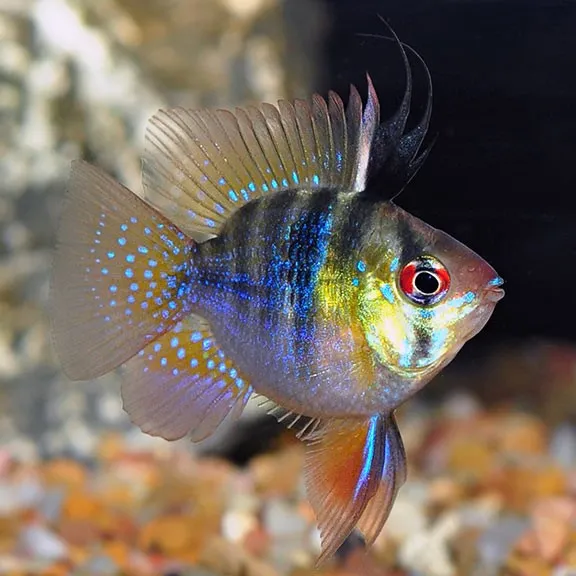
The angel ram gets its name because of being similar to the famous angel fish. These species have longer pectoral and dorsal fins compared to basic german rams. The body of the fish is also small and round, similar to a balloon type of ram cichlid. Here is more information about these species:
- Scientific name: Mikrogeophagus ramirezi ‘Angel’
- Origin: Captively bred, but originates from South America
- Rarity: Rare
- Price: Can cost from 30$ to about 60$
- Care level: Hard
- Water Temperature: 28–30 °C (82–86 °F)
- pH: 6.0–7.5
- Minimum Tank Size: 25 gallons for a pair
- Diet: omnivorous (can eat bloodworms, plant matter, fish food, pellets, brine shrimp)
- Temperament: Peaceful, but can become aggressive while breeding
- Lifespan: 2-4 years
- Size: up to 2.5 inches (6.35 cm)
Angel rams are also unique when it comes to coloration: the head is usually yellow or orange, while the body is covered in black stripes and bright blue dots. The fins also can develop orange coloration and blue dots.
Frequently Asked Questions
Can You Mix Different Ram Cichlids?
Mixing different ram cichlid types is fairly common, and can definitely be done. Be sure to check, if the water conditions for your types of cichlids are similar, and that there is enough room in your fish tank.
Can Ram Cichlids Crossbreed?
Most of the ram cichlids are only different colorations of the same ram cichlid species, which means that they can crossbreed. A german ram could definitely breed with a golden ram, but a bolivian ram couldn’t breed with a german ram, since they are different species.
Writer's Thoughts
Ram cichlids can be an amazing addition o an aquarium, you can choose from so many different ram cichlids variants to suit your needs. Be sure to always properly take care of your ram cichlids because you can certainly get the most out of them when they are healthy.
If you enjoyed reading our article, please feel free to share it with your friends by clicking the social media buttons below:

Thank you for reading my blog post. This website was created with the sole intention of providing quality information regarding fishkeeping. I have been in the fishkeeping hobby for 8 years, and through many trials and errors as well as online research I gathered a lot of information, which I want to give back to the community.

